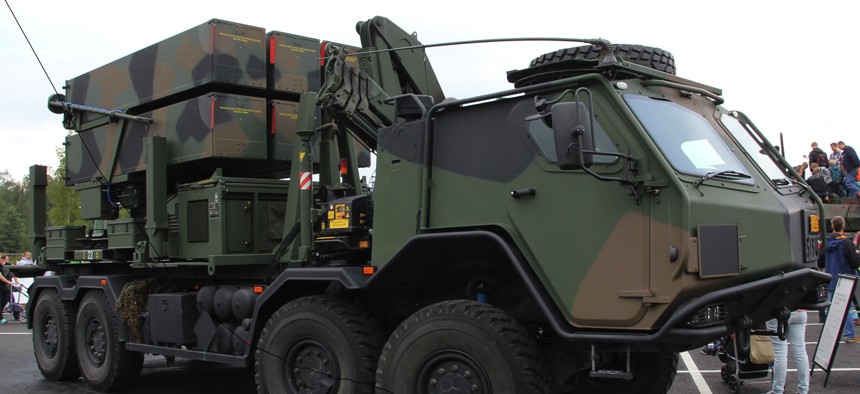
The National Advanced Surface to Air Missile System, or NASAMS. U.S. Army
US Trying to Persuade More Allies to Send NASAMS Missiles to Ukraine, Raytheon CEO Says
If U.S. officials can broker a deal, Kyiv won’t have to wait for factory-produced interceptors.
U.S. officials are working to broker a deal with NATO and Middle Eastern nations to send some of their NASAMS interceptors to Ukraine, Raytheon Technologies CEO Greg Hayes said Thursday.
The deal would allow Ukraine, which has reportedly been putting its recently received National Advanced Surface to Air Missile Systems to very effective use against incoming Russian missiles, to avoid a two-year wait for new ones from Raytheon’s factory, Hayes said in an interview.
“The DOD is going to attempt to do some trading for us where we'll take some from the Middle Eastern countries that are our friends and some from our NATO allies, and try and get those into Ukraine early next year,” the CEO said. “Then we'll backfill [those countries] with new production over the next two years.”
Hayes did not mention specific countries.
NASAMS are operated by five NATO members—Hungary, Lithuania, Netherlands, Norway, and Spain—and Oman and Qatar in the Middle East, according to Forecast International. Australia, Chile, Finland, and Indonesia also operate the system.
Hayes spoke the day after the Army awarded Raytheon a $1.2 billion contract for the remaining six of eight NASAMS interceptors promised by the Biden administration.
“This is gonna take us a full two years to fulfill this contract,” Hayes said. “Unfortunately, there's no magic box that allows us to just build them every day.”
The Army said it “along with industry partners, will work to shorten the 24-month production lead time associated with production and delivery of NASAMS. This effort further illustrates the urgency the U.S. government is taking in its approach to acquire air-defense systems for our allies and to replenish our own munition stockpiles.”
The Army statement did not mention allies giving NASAMS to Ukraine.
“This is a good reminder of the benefits of having a consortium of a lot of countries that have the same or similar systems so that they can not only pool on modernization improvements, but also flex and share among each other,” said Thomas Karako, a missile defense expert with the Center for Strategic and International Studies.
In August, the Pentagon awarded Raytheon a contract for the first two NASAMS batteries. The company delivered the interceptors within six weeks, Hayes said, because it had many parts on hand and because Doug Bush, the Army’s top weapons buyer, helped speed things along.
“Acquisition speed and agility is a top priority,” Bush said in a statement Wednesday. “The rapid award of this contract is another example of the Army’s ability to accelerate the delivery of critical capabilities through our industry partners to our allies.”
Since NASAMS arrived in Ukraine, U.S. officials say, it has compiled a perfect record against Russian missiles. On the first two days it was deployed, the Ukrainian military shot down 25 incoming missiles with 25 interceptors, Hayes said. Last month, U.S. Defense Secretary Lloyd Austin said NASAMS retained that 100 percent success rate, a claim reiterated on Wednesday by National Security Council spokesman John Kirby.
Sourcing more NASAMS is only part of the challenge, Hayes said.
“The long pole in the tent is actually not this trading of NASAMS systems, it’s getting enough Ukrainians trained on how to use the systems,” he said.
Ukraine’s current crews were trained by Norway, which developed NASAMS with the United States, Hayes said.
“We're gonna have to train a couple of hundred more folks before we can effectively deploy these systems,” he said.
Normal training on the system takes about six months, Hayes said. That has been compressed to 60 days, as instructors largely focus on how to operate the system. What’s left out of the training is maintenance and repair work.
“We're going to need to train these guys on how to sustain these things at some point, because they're going to wear out,” he said.
While Javelin anti-tank missiles and Singer shoulder-fired rockets are expendable and don’t need long-term maintenance, the NASAMS launchers will need to be overhauled at some point, Hayes said. And since U.S. forces or contractors cannot operate in Ukraine, the systems will have to be sent elsewhere in Europe for the overhauls.
“NASAMS is the first big weapons system that's going to require long-term sustainment,” he said. “We've started to have discussions with DOD, but we are not in a position yet, I would say to have a contract to sustain these things.”




